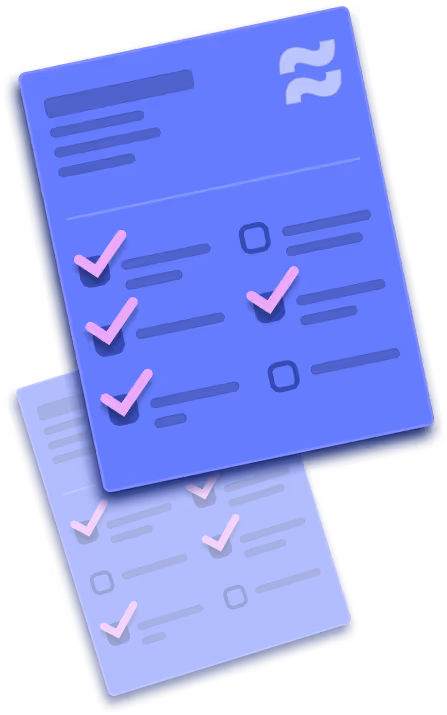.png)
What Is a Lead Magnet? Definition, Examples + Best Practices
Key takeaways
- Lead magnets capture warm, high-intent leads who’ve already interacted with your brand—much more effective than cold outreach.
- A lead magnet is a free, high-value resource offered in exchange for contact details and should directly solve a key audience pain point.
- Strong implementation requires strategic placement, compelling CTAs, mobile optimization, and ongoing A/B testing.
- Lead magnets work best when paired with automated follow-up emails that nurture prospects toward a purchase.
- Effective examples include calculators (Klara), quizzes and resource hubs (Lepaya), and gated content libraries (Upwork).
- Lead magnets come in many formats—eBooks, templates, tools, quizzes, webinars, trials—and without them, you miss out on converting hesitant buyers.
Imagine this: you are selling a product or a service as a SaaS or a startup, and you’ve just created a website.
It’s all sunshine and rainbows at the beginning until you realize nobody is scheduling calls with your sales team via the website.
It’s time to reach out to potential customers. But where do you start?
Here’s how I see it: you either give TONS of money for a questionable list of leads and start doing cold calls 24/7 or you try to find leads that have interacted with your brand and are more likely to buy what you’re selling.
The second option seems to be more effective, I’d argue. And to collect such leads, you need to do one thing with your website: add lead magnets.
Lead magnets are an important step in any company’s marketing and sales strategy. In this comprehensive guide, I will provide a definition, along with a detailed guide on how to create them and let them do their magic.
Finally, I will share some fantastic lead magnet examples and ideas I’ve stumbled across the web.
Read on.
What Is a Lead Magnet and How Does It Work?
To put it in simple terms, a lead magnet is a free item or service that is given away to gather contact details.
Let’s walk you through an ideal scenario of how lead magnets work:
- A visitor lands on your website (either organically with SEO or via paid ads).
- They stumble upon a section offering something for free and decide they like it.
- They click on the CTA and are prompted to enter their information (in most cases, it is their email address and name, but some businesses also ask for a phone number).
- They access the free item you offered and you get their information.
- This information is added to your CRM software and you start nurturing and prospecting leads.
Now nurturing and prospecting leads is a topic we might cover sometime in the future. For now, I want to focus mainly on lead magnets, as they are something we have had a chance to implement many times before for our clients.
How to Create a Lead Magnet
Creating a lead magnet is all about two things: making something irresistible and then strategically placing it on your website to catch as many leads as possible. Let’s break it down.
Create the Free Item
The first part is coming up with the free item or service you’ll offer. Think about what your ideal customer needs or struggles with—this is your golden opportunity to step in and help them out. Here’s how to do it:
- Understand your audience: What are the common pain points your customers face? Use this insight to create something they’ll find genuinely useful.
- Pick the right type of magnet: Lead magnets can be anything from eBooks and whitepapers to templates, checklists, or free trials. Choose something that aligns with what your audience needs and what you’re selling.
- Make it high-value: Even though you’re giving it away for free, it should feel like something worth paying for. High-quality content, clear design, and real value are non-negotiables.
- Stay relevant: Your lead magnet should connect directly to your product or service. The goal is to help your lead solve a problem that your offering can also address, making the transition from freebie to paid solution smooth.
Implement It on Your Website
Once you’ve got your lead magnet ready to go, it’s time to put it to work. Here’s how to make sure it gets the attention it deserves:
- Place it where It counts: Identify the most visited pages or strategicall most important pages on your website—whether it’s your homepage, blog posts, or specific landing pages—and make sure your lead magnet is front and center.
- Use strong CTAs: Your call-to-action needs to grab attention and make it easy for visitors to say “yes” to your offer. Consider using pop-ups, slide-ins, or sticky bars to make sure it doesn’t go unnoticed.
- Think mobile: A lot of your visitors will be on their phones, so make sure your lead magnet looks just as good on mobile as it does on desktop.
- Test, test, test: Experiment with different headlines, placements, or even the type of lead magnet you offer. A/B testing can help you figure out what works best.
- Follow up: Don’t let the connection end once someone opts in. Set up an automated email sequence to nurture your new lead—provide more value, introduce them to your products or services, and gently guide them towards making a purchase.
By focusing on these two areas—creating something your audience can’t resist and put it in the right places—you’ll be well on your way to building a solid list of leads who are much more likely to become paying customers.
Lead Magnet Examples
Want a lead magnet example? Check it out below, and feel free to test it.
{{cta}}
This was our lead magnet, which offers great value but is standard (that works best for us). However, we had an opportunity to do some amazing lead magnets for our clients.
Let’s check them out.
Klara Cost Calculator
One cool example I love to share is the work we did for Klara. We built three different cost calculators that help potential customers figure out just how much money they’re losing from abandoned calls and missed appointments.
Now, these calculators aren’t gated content. Instead, they serve as an entry point for website visitors, an asset for paid ads, and a handy tool for the sales team.
If you’re thinking about using this kind of lead magnet, it’s crucial to set up your page correctly. The goal is simple: convert those visitors into leads. Make sure your page structure supports this objective and guides users smoothly through the process.

Lepaya Quiz
Lepaya, a client who migrated their website from Wordpress to Webflow and nailed it with Webflow by creating a resource center loaded with diverse lead magnets.
Their site features a range of offerings: from handbooks and templates to whitepapers and engaging quizzes. One of the highlights is the skill gap analytics tool we developed. It’s a straightforward, actionable way for users to pinpoint skill gaps within their teams.
Here’s the twist: after completing the quiz, users need to provide their contact details to receive their results. This turns the quiz into a dynamic lead generation tool.
I’m particularly fond of this example because it shows that lead magnets can be both valuable and entertaining, breaking away from the usual monotony and making the experience enjoyable for users.

Upwork Resources Center
Upwork has done an impressive job with their resource center, which is brimming with lead magnets like white papers, calculators, eBooks, research reports, and guides.
Most of this content is gated, enabling the Upwork team to capture a substantial number of marketing-qualified leads every day.
What’s great about using Webflow for setting up a Resource Center is that it empowers your marketing team to continuously create and publish new lead magnets on their own. This approach not only speeds up your go-to-market time but also keeps your marketers smiling.

Lead Magnet Ideas
By now, I’ve explored and mentioned a couple of ideas for lead magnets. The truth is that there’s no one-size-fits-all solution here. Start with the one that makes the most sense.
Still, I wanted to provide some of the most popular lead magnet ideas. Let’s take a closer look.
- Whitepapers and eBooks: In-depth documents that provide detailed information on a specific topic, offering valuable insights and research.
- Courses: Structured educational content, often delivered as a series of lessons, designed to teach a specific skill or subject.
- Live or On-Demand Webinars: Interactive or pre-recorded presentations that provide expert knowledge and engage audiences in real-time or at their convenience.
- Interactive Tools and Calculators: Online tools that allow users to input data and receive personalized insights, making complex tasks easier to manage.
- Free Trials and Demos: Limited-time access to a product or service, allowing potential customers to experience its benefits firsthand.
- Case Studies and Success Stories: Detailed accounts of how your product or service has helped others, demonstrating real-world success and credibility.
- Quizzes and Assessments: Engaging tests that provide personalized results, helping users better understand their needs or preferences.
- Discounts: Offers of reduced pricing that incentivize potential customers to make a purchase.
- Exclusive Content: Premium material such as early access to blog posts, podcasts, or videos, available only to those who sign up.
- Content Upgrades: Bonus resources related to a specific piece of content, offering additional value in exchange for contact information.
- Guides and How-tos: Step-by-step instructions that help users achieve a specific goal or solve a problem.
- Checklists and Cheat Sheets: Concise, actionable lists that help users ensure they don’t miss any important steps or details.
- Templates and Swipe Files: Pre-designed documents or scripts that users can easily customize and implement in their own projects.
- Free Consultations or Strategy Sessions: Personalized advice from an expert, helping potential customers address their specific challenges.
- Worksheets and Workbooks: Interactive documents that guide users through exercises to help them apply what they've learned.
- Resource Libraries: Collections of valuable content, like eBooks, templates, or guides, that users can access all in one place.
- Surveys and Polls: Tools that gather user input and provide customized feedback or insights based on their responses.
Some lead magnets may perform better than others, but one thing is certain: with 0 lead magnets, you will get exactly a 0% chance to convert all those customers who are not ready to buy yet.
Final Thoughts
Lead magnets can help you immensely in your overall marketing and sales approach and ultimately be an important cog in selling your product or service and generating profit.
Check out our 2025 Playbook to Website Optimization For Customer Acquisition to learn more about lead magnets and other popular strategies for leveraging your website to reach your business KPIs.
{{cta}}
FAQ for Lead Magnets
How can I measure the effectiveness of a lead magnet on my website?
Effectiveness can be tracked using metrics like conversion rate, bounce rate, time on page, and lead quality. Tools like Google Analytics and CRM platforms enable monitoring user interactions, opt-in completion rates, and downstream engagement after leads enter the funnel.
What are some common mistakes to avoid when offering lead magnets?
Common mistakes include offering low-value content, misaligning the lead magnet with your audience's needs, omitting a strong CTA, failing to optimize for mobile devices, and neglecting follow-up communication after users opt in.
How do lead magnets differ for B2B vs. B2C businesses?
B2B lead magnets typically offer in-depth resources like whitepapers or case studies focused on ROI and industry solutions, while B2C lead magnets often prioritize quick wins like discounts, quizzes, or lifestyle guides tailored to immediate consumer interests.
Can you use multiple lead magnets on one website?
Yes, using multiple lead magnets can cater to different audience segments and customer journey stages. By strategically placing various offers throughout your site, you can maximize lead capture opportunities without overwhelming users.
How do lead magnets integrate with SEO strategies?
Lead magnets enhance SEO by increasing time on site, encouraging engagement, and attracting backlinks when promoted via valuable gated content. Coupled with keyword-optimized landing pages, they help convert organic traffic into qualified leads.
What tools can help design and deploy effective lead magnets?
Popular tools include Canva for design, Typeform for quizzes, HubSpot for forms and automation, Webflow for web deployment, and ConvertFlow or OptinMonster for advanced targeting and A/B testing of lead capture forms.
How often should you update or change your lead magnet?
Review and update your lead magnets quarterly or after major shifts in customer behavior, industry trends, or product offerings. Regular updates ensure relevance, maintain engagement rates, and reflect current customer pain points or opportunities.






.svg)













.png)
.png)
.png)








.svg)

.png)
.png)
.webp)
.svg)

